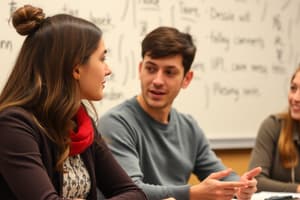Podcast
Questions and Answers
What does a growth mindset primarily emphasize about abilities?
What does a growth mindset primarily emphasize about abilities?
- Abilities can improve with effort and practice. (correct)
- Effort does not impact the development of abilities.
- Abilities depend solely on innate talent.
- Abilities are fixed and cannot be improved.
Which theory suggests that language influences thought and perception?
Which theory suggests that language influences thought and perception?
- Cultural Relativism
- Linguistic Relativity (correct)
- Social Constructivism
- Ethnocentrism
Which option exemplifies the instrumental function of language according to Michael Halliday?
Which option exemplifies the instrumental function of language according to Michael Halliday?
- “Let’s all stand and pray.”
- “I want him now.” (correct)
- “English is considered a universal language.”
- “In a faraway land, a magical kingdom…”
Which term describes a phenomenon where language reflects cultural values and social norms?
Which term describes a phenomenon where language reflects cultural values and social norms?
What is the term for a type of language variety distinguished by its specific vocabulary and grammar?
What is the term for a type of language variety distinguished by its specific vocabulary and grammar?
Which scenario is an example of sociolinguistic variation?
Which scenario is an example of sociolinguistic variation?
What challenge is often faced when studying the language-culture-society connection in multicultural societies?
What challenge is often faced when studying the language-culture-society connection in multicultural societies?
What concept best describes the perception of one's own culture as superior to others?
What concept best describes the perception of one's own culture as superior to others?
What is the primary function of language according to the principles outlined in the content?
What is the primary function of language according to the principles outlined in the content?
Which term best describes the idea that early human communication evolved from gestures and body movements?
Which term best describes the idea that early human communication evolved from gestures and body movements?
In Kachru's Concentric Circles Model, which group of countries belongs to the Expanding Circle?
In Kachru's Concentric Circles Model, which group of countries belongs to the Expanding Circle?
Which language register is characterized by language that never changes?
Which language register is characterized by language that never changes?
What does the concept of semanticity in language refer to?
What does the concept of semanticity in language refer to?
Which register is typically used among friends in informal settings?
Which register is typically used among friends in informal settings?
What is emphasized by the theory of ethnopoetics?
What is emphasized by the theory of ethnopoetics?
What does the concept of arbitrariness in language imply?
What does the concept of arbitrariness in language imply?
Which environment best supports immersive language learning?
Which environment best supports immersive language learning?
In a multilingual society, what term describes the practice of switching languages within a conversation?
In a multilingual society, what term describes the practice of switching languages within a conversation?
What key factor is essential for creating a positive language learning environment?
What key factor is essential for creating a positive language learning environment?
Which option best defines the Inner Circle in Kachru’s Concentric Circles Model?
Which option best defines the Inner Circle in Kachru’s Concentric Circles Model?
Which language register is represented in the phrase, 'Lol. You don't have the nerve to rat me out.'?
Which language register is represented in the phrase, 'Lol. You don't have the nerve to rat me out.'?
Which of the following describes the concept of 'arbitrariness' in linguistics?
Which of the following describes the concept of 'arbitrariness' in linguistics?
What does the concept of 'cultural relativism' imply?
What does the concept of 'cultural relativism' imply?
Which factor influences sociolinguistic variation in a community?
Which factor influences sociolinguistic variation in a community?
Flashcards
Instrumental Function of Language
Instrumental Function of Language
Using language to get what you want or need.
Linguistic Relativity
Linguistic Relativity
Language shapes how we think and perceive the world.
Linguistic Determinism
Linguistic Determinism
Language completely determines how we think.
Sociolinguistic Variation
Sociolinguistic Variation
Signup and view all the flashcards
Dialect
Dialect
Signup and view all the flashcards
Language-Culture-Society connection
Language-Culture-Society connection
Signup and view all the flashcards
Challenge in Multicultural Societies
Challenge in Multicultural Societies
Signup and view all the flashcards
Growth Mindset
Growth Mindset
Signup and view all the flashcards
Ethnopoetics
Ethnopoetics
Signup and view all the flashcards
Total Feedback
Total Feedback
Signup and view all the flashcards
Specialization of Language
Specialization of Language
Signup and view all the flashcards
Oral Gesture Theory
Oral Gesture Theory
Signup and view all the flashcards
Semanticity
Semanticity
Signup and view all the flashcards
Arbitrariness
Arbitrariness
Signup and view all the flashcards
Discreteness
Discreteness
Signup and view all the flashcards
Impression Management
Impression Management
Signup and view all the flashcards
Immersion Learning
Immersion Learning
Signup and view all the flashcards
Code-Switching
Code-Switching
Signup and view all the flashcards
Conducive Learning Environment
Conducive Learning Environment
Signup and view all the flashcards
Slang Register
Slang Register
Signup and view all the flashcards
Inner Circle (Kachru's Model)
Inner Circle (Kachru's Model)
Signup and view all the flashcards
Duality of Language
Duality of Language
Signup and view all the flashcards
Arbitrariness of Language
Arbitrariness of Language
Signup and view all the flashcards
Productivity of Language
Productivity of Language
Signup and view all the flashcards
Study Notes
Language, Culture & Society
- Language: A system of vocal symbols for human communication.
- Culture: Shared perspectives, values, beliefs, and experiences (way of life).
- Society: A group of people living together with structure.
- Dialect: A unique language variety specific to a group or region.
- Sociolinguistics: The study of the interrelation between language and society.
- Code-switching: Using two or more dialects/languages in a conversation.
- Language Acquisition: The process of learning a language (first or second).
- Bilingualism: The ability to speak and understand two languages.
- Anthropology: The scientific study of human culture and societies.
- Cultural Relativism: The belief that cultural practices should be evaluated within their own cultural context.
- Cultural Appropriation: Taking aspects of one culture by another without proper recognition or respect.
- Artifacts: Objects created by a particular culture often possessing cultural significance.
- Ideology: Fundamental principles and morals supporting political/social systems.
- Ethnocentrism: Evaluating other cultures based on one's own culture's norms.
- Xenocentrism: Preference for the cultural practices of other cultures.
- Social Stratification: System of authority and status levels in a society.
- Social Mobility: The ability to move between social levels.
- Social Cohesion: The extent to which individuals feel connectedness in a society.
- Native Language: The first language learned.
- Second language (L2): Any language learned after the native language.
Theories in Language and Culture
- Sapir-Whorf Hypothesis: Language shapes thoughts and perception.
- Linguistic relativity: Language influences how people experience and perceive the world.
- Ethnopoetics: Analyzing and recording oral poetry/narratives to preserve their formal and functional elements.
- Cultural Capital: Knowledge, skills, and practices used to navigate social context and are unequally distributed.
- Impression management: Strategies people use to create a particular impression on others.
- Nonverbal communication: Significant in understanding social interactions.
Language Learning Environments
- Classroom-based: Traditional classrooms.
- Language Labs: Equipped with audio-visual aids.
- Online-based: Courses available online.
- Immersive: Exposed to the language in its natural context.
- Study Abroad: Learning a language in a country where it is spoken.
- Home-based: Using language software/tutors.
- Social Media: Using platforms for learning/interaction.
- Language Exchange Groups: Informal gatherings to practice language.
- Community-based: Community events/volunteering to learn language.
Language and Culture: Key Concepts
- Language Barriers: Understanding different languages is important.
- Cultural Differences: Awareness of cultural variations in communication.
- Resources: Availability of learning materials, teachers, and technology.
- Classroom Management: Working with diverse language learners effectively.
- Student Motivation: Promoting engagement in learning.
- Parental Involvement: Family support is crucial for language development.
- Standardized Testing: Emphasis on rote-learning rather than deeper understanding.
- Pedagogical Trends: Adapting to the latest learning theories/methods.
- Professional Development: Continuously building skills to meet students' needs.
Mock Test - Language and Culture (Multiple Choice)
- Question 1: Identifying a language learned to supplement the native language within the same country.
- Question 2 (Theories): Defining the theory that suggests language is a tool for social action.
- Question 3: Defining the concept that language influences the perception of the world.
- Question 4 (Example): Identifying an example of instrumental language function.
Studying That Suits You
Use AI to generate personalized quizzes and flashcards to suit your learning preferences.




